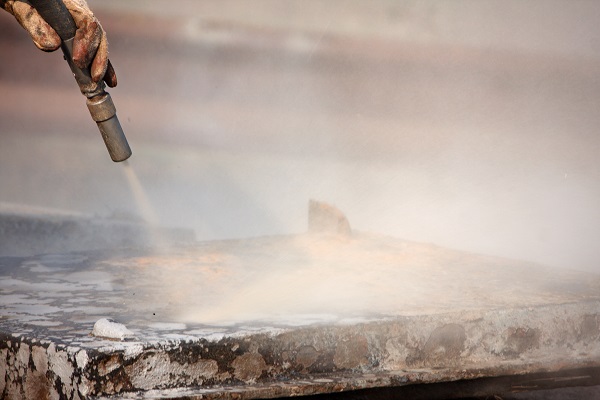Marine, industrial and commercial workers are mostly familiar with the practice of sandblasting and sandblasting injuries. Abrasive blasting is still commonly referred to as sandblasting due to the use of silica (sand) as a popular abrasive. Today there are many other forms of abrasives used. Abrasives range from silica, crushed coal, and even walnut shells for sensitive areas.
Sandblasting is used to remove paint and other materials from a substrate to clean it before it is to be repainted. This activity is highly effective but can be quite dangerous if proper precautions are not taken.
Common Sandblasting Injuries and How They Occur
Sandblasting injuries can happen in the workplace when equipment is not properly maintained or used. Always check hoses to make sure they are wired together and will not come undone during blasting. Sandblasting injuries can also result from improper personal protection equipment not being provided or worn.

Silicosis
Sandblasting injuries can result from many different hazards. Sandblasting creates dust. Breathing in dust from silica can lead to a deadly disease called silicosis. Sandblasting dust can also contain chemicals that were present on the substrate. It is absolutely necessary that sandblasters wear their blast hoods, long sleeves and gloves at all times to prevent sandblasting injuries.
Hearing Loss
Sandblasting injuries are not always a direct result of the dust. Sandblasting is an extremely loud activity. Hearing loss is a real possibility for blasters and many already suffer from it. Even though blasters wear hoods, it is still important to wear earplugs. This is even more important when blasting inside enclosed spaces like tanks where much blasting takes place.
Limb Injuries
The abrasive stream is extremely dangerous and blasters should take care to not extend their limbs into the stream. Sandblasting injuries resulting from getting shot at close range to the blasting nozzle can be devastating and excruciatingly painful. These sandblasting injuries can result in loss of use of the affected limbs. Corrective surgeries may also be necessary.
Improper “Dead-man” Switch Use
The most common way sandblasting injuries can occur is by improper use of the “dead-man” switch. The “dead-man” switch is the device that will shut off the sandblasting equipment if switch is not being held down by the blaster. So if a blaster drops the hose, the “dead-man” switch should shut off the flow of sand through the nozzle.
Sometimes, blasters will wedge a piece of foam or something else under the switch so they do not have to hold it down the entire time. This is a good way to increase the likelihood of sandblasting injuries. By rigging the “dead-man” switch, the blaster ensures that if he drops the hose, the sandblasting equipment will not shut off as it was designed to do.
A loose sandblasting hose will whip around and spray anyone in the general area. Rigging the “dead-man” switch not only endangers the blaster, it endangers everyone nearby.
Sandblasting Injures Caused by Negligence
Following these tips are a start to ensuring sandblasting safety. It is the job of maritime employers to ensure that workers have the proper training and safety equipment, that equipment is properly maintained, and that safety protocols are adhered to. When a worker is injured as a result of negligence by a maritime employer, ship owner or co-worker, it’s important that they seek help protecting their legal rights.
The maritime injury attorneys at Lambert Zainey represent victims of sandblasting accidents. If you or a loved one has been injured working in the maritime or offshore industry, call Lambert Zainey today for a free case evaluation.







